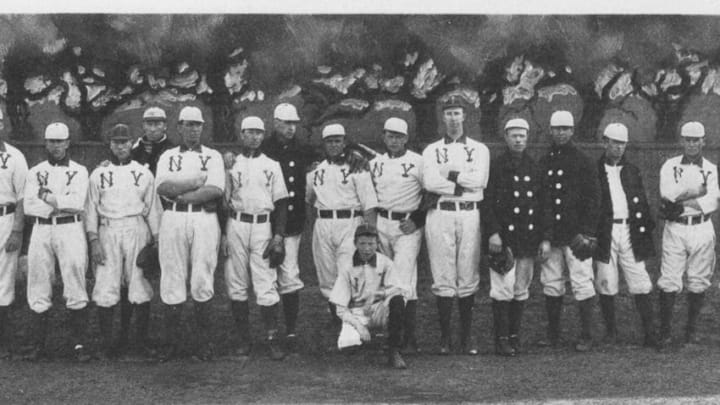The Boston Red Sox and New York Yankees have been at it for almost the entire history of the American League. Now a look at where it all began.
Where did it begin? The Red Sox-Yankees rivalry certainly had a beginning since it is the most notorious of all baseball hostilities. The fans of both teams actually hate each other and occasionally a grudging acknowledgment of respect will surface. The history is clear as Boston Red Sox fans have had to endure taunts for the decades of incompetence that was finally and gleefully eradicated with the historic comeback in 2004. But let’s travel back to 1904.
The Yankees were not the Yankees but the Highlanders and the Red Sox were not the Red Sox but the Americans, but I will refer to them in their current naming incarnation. The Yankees were also not originally in place in New York City but immigrated from Baltimore when purchased by Frank Farrell and Bill Devery in 1903. The nickname of Highlanders was the result of their new ballpark called Hilltop Park. A typical clever New York connection.
In 1903, there was no hint of the magnificent carnage – mostly verbal – that would punctuate the history of both teams. The Red Sox won the pennant and the subsequent World Series while the Yankees finished fourth in an eight-team league. The following season would have different circumstances and it would all culminate in a bizarre five-game series at the end of the season to determine the pennant.
The schedule called for the five games to be played at Hilltop Park, but the owners had already committed one date to a college football game, forcing a strange schedule adjustment. The first game was played in New York and the Yankees won 3-2 on October 7 and then both teams packed up and traveled to Boston for a double-header on October 8 with New York now clinging to a one-half game lead. A two-game set on Boston turf thanks to football.
The Red Sox played their games at the Huntington Avenue Grounds and if there was any place to stuff a patron for that game it was found. Attendance for the twin bill was listed at 35,000 and they were not to be disappointed. The first game was an old fashion offensive beat down with Boston prevailing 13-2. Bill Dinneen was the winning pitcher and Jack Chesbro absorbed the loss. Chesbro had also won the previous day to have his record sit at a comfortable 41-10.
The second game was a pitchers duel and for that, you have one of the most notable names among pitchers – Cy Young came out the winner in a 1-0 contest. The Red Sox and Yankees again pulled up stakes and headed to New York, but Boston had as part of their entourage a secret weapon – the Tessie singing Royal Rooters all 300 strong to serenade the Noo Yawkers.
The double-header needed a Yankees sweep to clinch the title and Boston interest was keen at both the ballpark and at home. Remember, Boston and New York were rivals not only in sport but finance, education, politics, and just about everything else. This series would be the baseball version of the Thirty Years War.
Another 35,000 came prancing into Hilltop and again Chesbro took the mound against “Big Bill” as Dinneen was called. Dinneen was a money pitcher going 3-1 in the World Series against the Pirates in 1903 and he was on his game as was Chesbro.
More from Red Sox History
- Two notable Red Sox anniversaries highlight current organizational failures
- Contemporary Era Committee doesn’t elect any former Red Sox to Hall of Fame
- Johnny Damon calls Red Sox out, reveals hilarious way he skirted Yankees’ grooming policy
- Remembering the best Red Sox Thanksgiving ever
- Red Sox World Series legends headline 2023 Hall of Fame ballot
Tied in the top of the ninth, the Red Sox had a runner on third when Chesbro – born in Massachusetts and known as “Happy Jack” – uncorked a wild pitch. The pitch was one Chesbro had used extensively during the season – a spitball. The Red Sox held off the Yankees and had a 3-2 victory making the second game a meaningless 1-0 Yankees win.
The Red Sox would not have to contend with another New York team in the postseason as the winners of the National League title the New York Giants refused to meet the Red Sox, nor would they have met the Yankees. Manager John McGraw of the Giants could care less about the American League upstarts.
Chesbro had a delightful season for those so interested in outrageous statistical numbers. Happy Jack went 41-12 and the next nearest in wins had 26. His 48 complete games led all others and his 454.2 innings topped teammate Jack Powell’s 390.1.
The Yankees did little for the rest of the decade and the next. The team floundered with a level of mediocrity, only five times pushing above .500 through 1919. The Red Sox were a different story with championships in 1912, 1925, 1916, and 1918. After that, the rest is history – a very bad history for Red Sox fans, but the roots of this rivalry date back to that season with an emphasis on that five-game series.
A final note on revenge happened in 1912 when the Red Sox opened Fenway Park and also went to the World Series where they met the Giants. The Red Sox won that series and that closed the circle on Mugsy McGraw and his avoidance in 1904.
Sources: SABR
Ed Linn: The Great Rivalry: The Yankees and the Red Sox
